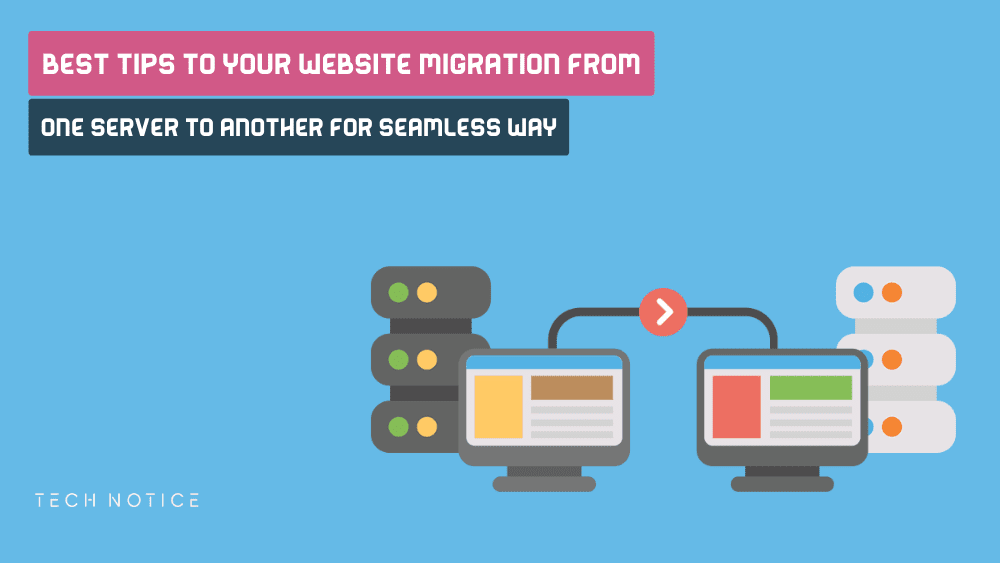# Best Tips To Migrate A Website From One Server To Another In A Seamless Way

Website migration can be a difficult or intimidating undertaking, but with the proper strategy, preparation, and direction, it shouldn’t be a concern for you.
A seamless transition is essential to prevent any disturbance to your online presence, whether you are moving a WordPress site to a new domain or new host, upgrading to a better server, or just restructuring your web infrastructure is important.
In this post, we’ll examine several crucial pointers and best practices to make the process of migrate your website simple and painless.
What is a Website Migration?
Migration refers to the process of moving website to a new domain from an old domain, or moving website to a new host from an old hosting.
A website migration service involves moving all necessary files, databases, configurations, and other website components from your current hosting provider to a new one.
Website migrations can happen for various reasons, such as upgrading to a better server, changing hosting providers, restructuring the site’s infrastructure, or changing domain provider.
The point of a website migration is to seamlessly move a website to a new environment without any disruption to its functionality or performance of the website, or overall user experience.
Why Migrate Your Website?
Before we dive into the tips, let’s briefly discuss why you’d consider migrating your website in the first place.
There could be several reasons behind this decision:
- Improved performance: Upgrading to a more powerful server or choosing the best hosting provider with better infrastructure can greatly improve website speed and performance.
- Scalability: If your current hosting plan no longer meets your site’s needs, moving to a more scalable solution will ensure your website can handle increased traffic and resource demands.
- Reliability and Security: Switching to a reputable hosting provider with strong security measures can protect your website from potential threats and vulnerabilities.
- Cost: Migrating to a different hosting provider or plan can help you find a more efficient solution or get cheap hosting.
Now that we understand the drivers behind website migration, let’s explore some tips for ensuring a smooth transition.
Tips for a smooth website migration
1. Planning Before Moving The Site
Good planning is the solid foundation for a successful site migration.
You should start by defining a detailed migration strategy, including schedules, tasks, and responsibilities.
Consider the following key aspects:
* Create a checklist: List all necessary steps involved in the migration process, such as DNS changes, domain transfer , database migration, and testing.
Having a comprehensive step-by-step list will help you stay organized throughout the moving and commissioning process.
* Choose the right timing: Choose a time when your website is experiencing relatively low traffic to minimize the impact on your users or your site.
* Back up your data: Be sure to back up all of your website data, including files, databases, and configurations.
This step is important to ensure that you can restore your website in case of any unexpected problems during moving a WordPress site.
2. Select a Good and Reliable Hosting Provider
When deciding to migrate your website, choosing a good and reliable hosting provider is essential, so, you need to learn what is a type of hosting and what you need in hosting.
There are many good and recommended hosting sites such as Hostinger or hostgator , which may be able to get cheap hosting at good prices, in addition to other good features.
Consider the following factors when choosing a new host:
* Performance: Choose a hosting provider that offers excellent server performance, including fast load times, high uptime, and enough resources for your website’s needs.
* Technical Support: Ensure that your hosting provider offers reliable technical support, ideally 24/7, to assist you during the migration process and address any issues promptly.
* Security Measures: Prioritize a host that implements robust security measures, such as firewalls, DDoS protection, and regular backups, to protect your website from potential threats.
* Scalability options: If you anticipate growth in the future, choose a hosting provider that offers scalable plans, allowing you to easily upgrade your resources as your website expands.
3. Test Before Publishing your Website
Before pointing your domain to the new hosting server, it is essential to thoroughly test your website on the new environment.
This ensures that everything works as expected and reduces the chances of any unexpected issues occurring after the migration.
Consider the following steps:
* Test functionality: Check all website functionality, including forms, shopping carts, user registrations, and site sections, to ensure they are working correctly.
* Cross-browser compatibility: Verify that your website appears and works correctly across different browsers and devices, such as smartphones.
* Link and Image Check: Check that all links and images on your website are correct to ensure they are not broken or missing.
* Performance Test: Measure the loading speed of your web pages and improve if necessary to ensure optimal performance on your new hosting server.
* User Experience Testing: Ask a group of users to navigate through your website and provide feedback on any issues they may encounter.
4. Update your DNS Records Carefully
Updating DNS ( Domain Name System ) records is a critical step in the website migration process.
DNS records associate your domain name with the IP address of your hosting server.
To update your DNS records without causing any disruption to the site, follow these instructions:
* TTL Considerations: Before migrating, set a low TTL value for your DNS records, as this allows changes to propagate faster once the records are updated.
* Add New DNS Records: Create the necessary DNS records on your new hosting server before updating your DNS settings, this ensures that your website resolves properly after migration.
* DNS Propagation Monitor: to Monitor the DNS propagation process, which can take anywhere from a few minutes to 48 hours, use online tools to check if your DNS changes have propagated globally.
5. Monitor Website Performance
After the migration is complete, keep a close eye on your website’s performance to make sure everything is running smoothly.
Consider the following:
* Uptime Monitoring: Use monitoring tools to track your website’s uptime and receive notifications if any downtime occurs.
* Performance optimization: Continuously improve your website’s performance by implementing technologies such as caching, content delivery networks (CDNs), and image compression .
Set up error tracking and monitoring to identify and resolve any issues that may arise after migration, such as broken links or server errors.
The following actions can be taken to address and fix the problems:
* Remain composed and evaluate the situation: Take a deep breath, remain composed, and then evaluate the nature of the issue and its implications for the migration procedure and website functionality.
* Return to your backup: If a problem arises while you are migrating, check the backup you made before migrating, In the event of any unforeseen complications, you may restore your website to its original condition using this backup.
* Identify the underlying cause: Make an effort to identify the issue’s underlying cause, examine any accessible logs or error messages to find the issue with the Internet, You will be better able to troubleshoot after understanding what went wrong and how it happened.
* Request technical support: If you’re having difficulties resolving the issue on your own, feel free to contact the technical support staff at your hosting company, They have expertise with migration-related problems and can offer advice and aid in troubleshooting the issue.
* Effective communication: Describe the problem you’re having to our technical support staff in detail, including any measures you’ve done, any error messages you’ve gotten, and how it’s affecting the operation of your website.
* Comply with the technical support instructions: Carefully listen to and comply with the technical support team’s instructions, They may ask you for further details or need you to carry out particular actions in order to identify and fix the issue.
* Write down the issue: Keep track of the issue, including any troubleshooting actions done, and any technical assistance answers supplied, this documentation may be helpful in the future or if similar problems happen throughout the migration process.
* Think about hiring experts: If the issue persists, or you require specific knowledge, think about hiring skilled web developers or migration professionals, They can give advanced debugging, discover difficult problems, and provide specialized solutions.
Remember that having problems throughout the relocation process is normal, and that most problems can be successfully fixed with the correct strategy and assistance.
In average, it can take anywhere from a few hours to several days to transfer a website.
The transfer procedure can be finished in a few hours for smaller websites with easier configurations.
This involves updating DNS records, establishing the new hosting environment, migrating databases, and relocating website files.
It is crucial to remember that the time may change depending on the particular needs of the website and the hosting company’s infrastructure.
Large websites, on the other hand, may take longer to load if they have complicated configurations, huge databases, or a lot of data.
To ensure a smooth transition, careful preparation, exhaustive testing, and data transfer are required while migrating these websites.
For these kinds of websites, the migration procedure may take many days to finish.
It should be noted that other factors, such as data throughput, network connectivity, the effectiveness of migration tools, or hosting provider support, may also have an impact on the timeline.
It is advised to speak with your hosting company or a migration specialist for a more precise estimation of the time required to migrate your website because they may offer advice based on your particular needs and circumstances.
Conclusion
Migrating a website might seem like a complicated process, but by following the tips outlined in this article, you can ensure a smooth and seamless transition to a new hosting provider.
Remember to plan ahead, choose a reliable hosting provider, perform thorough testing before you publish your site, update your DNS records carefully, and monitor your website’s performance after migration.
By approaching the migration process methodically and patiently, you can minimize downtime, prevent data loss, and provide your users with a good experience.

Cloud Hosting Vs VPS Hosting: Which is Right for Your Website?
By Zouani in - 16 Mar, 2024
Website Data Backup And Recovery: What Is It, And How Is To Work?
By Zouani in - 16 Feb, 2024
Understanding What Is The Difference Between Storage Space And Bandwidth In Hosting
By Zouani in - 16 Feb, 2024
What Is The Difference Between Cloud Hosting And Traditional Hosting?
By Zouani in - 17 Jan, 2024
What Is The Difference Between Managed Vs Unmanaged Hosting?
By Zouani in - 23 Oct, 2023
Third Time will Lucky: How You Can Conquer WordPress
By Zouani in - 23 Oct, 2023



